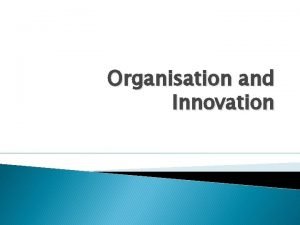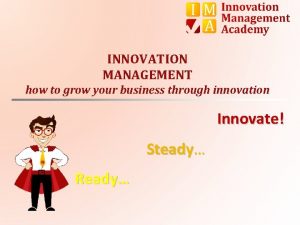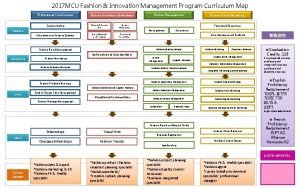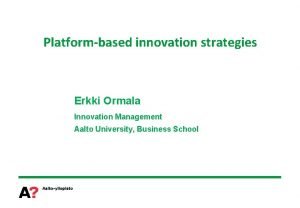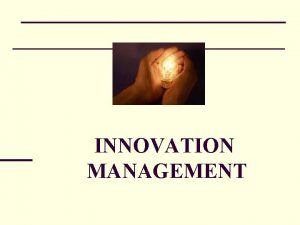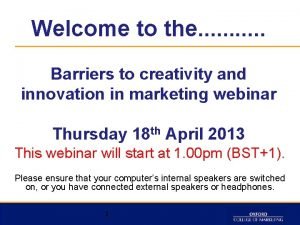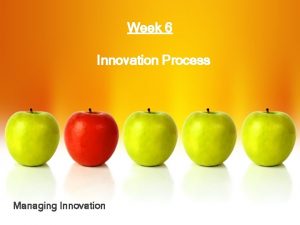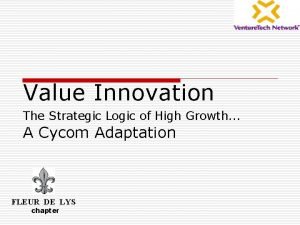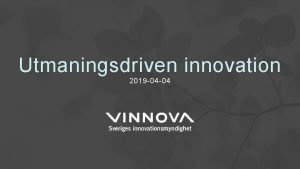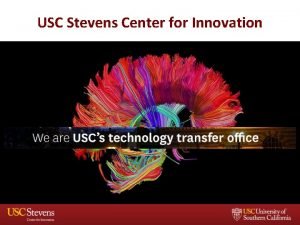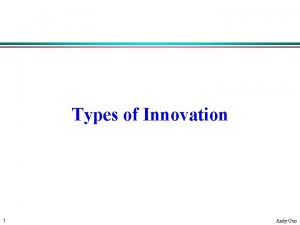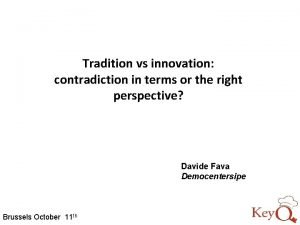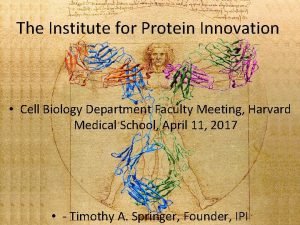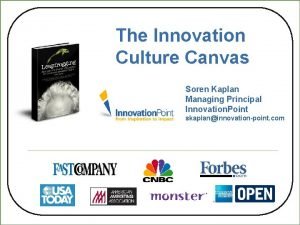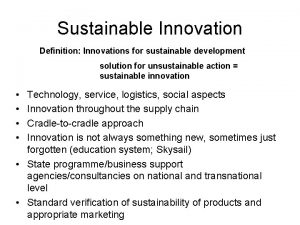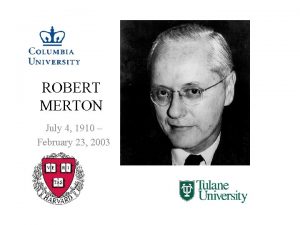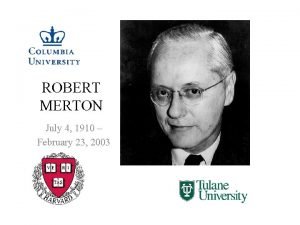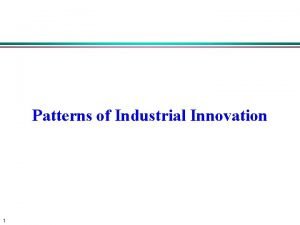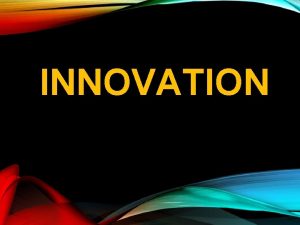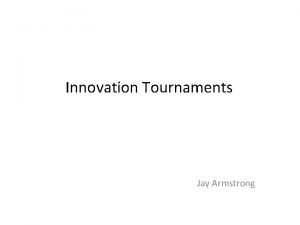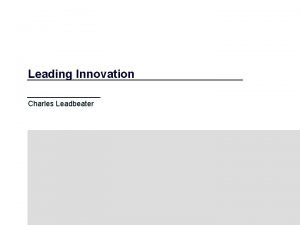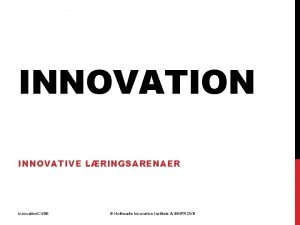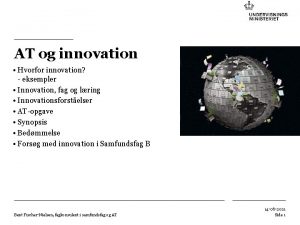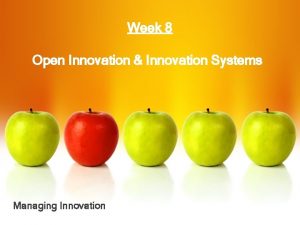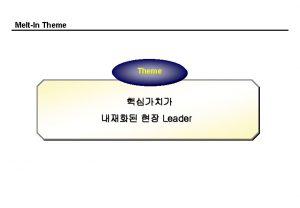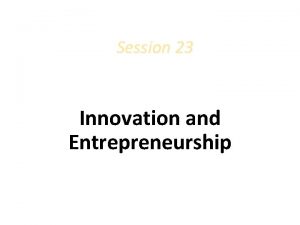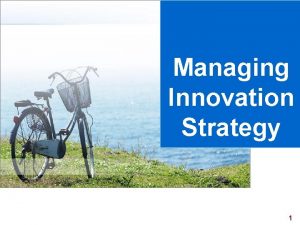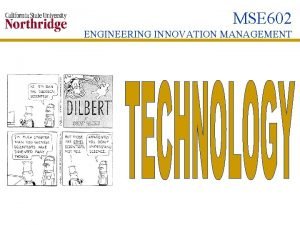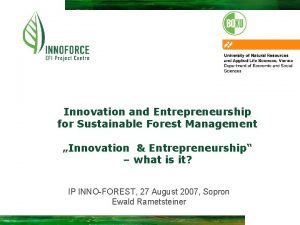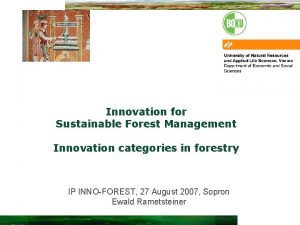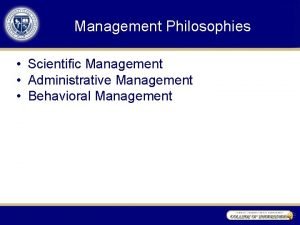INNOVATION MANAGEMENT WHAT IS AN INNOVATION It is






























- Slides: 30

INNOVATION MANAGEMENT

WHAT IS AN INNOVATION? It is an idea, practice or object that is perceived as new by an individual or other unit of adoption. It is a use of new knowledge to offer a new product or service that customers want. Thus, it is Invention + Commercialization. “Innovation is the search for and the discovery, developed, improvement, adoption and commercialization of new processes, new products and new organization structures and procedures. ”

Click to edit Master text styles Second level Third level Fourth level Fifth level

CHARACTERISTICS OF INNOVATION There is an object or target which is being changed. It can be a product, a process, an individual’s lifestyle, an organization's strategy, a society culture. Innovation vary in extent or magnitude i. e. degree to which one deviates from the past. It is closely related to problem solving since generation & implementation of ideas for change never transpire without difficulty. A final characteristic is the impact of the change, the significance or range of its effects.

Difference between Innovation & Invention Innovation 1. It’s creation of new product, service or process. • It is the introduction of new product, service or process into the marketplace. 2. May not be commercialized 2. Results into commercialization 3. It can be autonomous or induced 3. Usually induced 4. Can be for economic or noneconomic motive 4. Economic motive 5. Usually restricted to R&D centre 5. Spread across the organization 6. May bring few changes in organization 6. Brings organizational change 7. Precedes innovation 7. Succeeds invention

WHY INNOVATE ? ? ?

GOALS OF INNOVATION Improving quality Creation of new markets Extension of the product range Reducing labor cost Improving production process Reducing materials Reducing environmental damage Replacement of products/services Reducing energy consumption Conformance to regulations

SOURCES OF INNOVATION Organizational Structure. - Organic structures positively influence innovation. As there is lower vertical differentiation, formalization, centralization. Organic organizations facilitate the flexibility, adaptation & cross-fertilization. Long tenure in Management - Managerial tenure apparently provides legitimacy & knowledge of how to accomplish a task and obtain desired outcomes. Slack Resources - Having an abundance of resources allows an organization to afford to purchase innovations, bear the cost of instituting innovations & absorb failures. Interunit Communications - Innovative organizations are high users of committees, task forces, cross-functional teams that facilitate interaction across departmental lines.

TYPES OF INNOVATION Product & Process Innovation Open & Closed Innovation Incremental & Radical Innovation Modular and Architectural Innovation

PRODUCT & PROCESS INNOVATION Click to edit Master text styles Second level Third level Fourth level Fifth level

Open & Closed Innovation PROJECT START Concept Development CONCEPT FROZEN MARKET INTRODUCTION Implementation Closed Model For Innovation PROJECT START CONCEPT FROZEN MARKET INTRODUCTION Concept Development Implementation Open Model For Innovation

INCREMENTAL INNOVATION ● Click to edit the outline text format – Improving Inherent Second Outline Level ● – Processes/Inputs to achieve Higher Output Click to edit the outline text format – ● Third level – Fourth level Third Outline Level ● Fifth level Second Outline – Level ● – Fifth Outline Level Sixth Outline Level Second level ● Third level Click to edit ● the outline text format – Seventh Outline Level. Click to edit Master text styles Fourth level Fourth Outline Level ● ● Fifth Outline Level Sixth Outline Level Second level Fourth Outline Level ● – ● Seventh Outline Level. Click to edit Master text styles Third Outline Level – ● Second Outline Level ● Fourth Outline Level ● – ● Third Outline Level Fifth Outline Level Sixth Outline Level Seventh Outline Level. Click to edit Master text styles – Second level ● Third level – Fourth level

RADICAL INNOVATION Displacing Existing Technology

Architectural Innovation Change in Product Structure ● Click to edit the outline text format – Steam Engine of Car Modular Innovation Change in Component Technology Second Outline Level ● Third Outline Level Fuel Engine – Fourth of Car Outline Level ● Fifth Outline

INNOVATION PROCESS Recognizing or scanning the environment. Aligning the overall business strategy & proposed innovation. Acquiring technology from outside. Generating technology in-house. Exploring & selecting the most suitable response to the environment. Executing & implementing innovation. Learning lessons for improvement. Developing the organization.

INNOVATION OCCURS AT THREE LEVELS NATIONAL LEVEL GOVT. POLICIES & SUPPORT ENTERPRISE LEVEL ENTERPRISE POLICIES, SUPPORT & INITIATIVES INDIVIDUAL LEVEL INDIVIDUAL & GROUP INNOVATION ACTIVITIES

LEARN TIME

INNOVATION MANAGEMENT Innovation management is all about learning to find the most appropriate solution to the problem of consistently managing aforestated process doing so in the ways best suited to the particular circumstances in which the organization finds itself. It is the search of effective routines. It is about managing the learning process to deal with the challenge of the innovation process.

Innovation Management of Innovation comprises three things: - linking of engineering, - science & - management disciplines to plan, develop & implement technological capabilities to shape & accomplish the strategic & operational objectives of an organization.

Need/Objectives of Innovation Management To reap in the economic benefits of new technological inventions by commercializing them on time To integrate technology into overall strategic objective of the organization. To get into and out of the technologies faster and more efficiently. To accomplish technology transfer. To reduce new product development time. To manage large , complex & interdisciplinary projects and systems.

Organizational Process for Innovation Management

VALUE INNOVATION(VI) One of the most prominent programmatic approaches to innovation currently in use. It is different from building layers of competitive advantages & does not means segmenting market & accommodating customer needs. It’s main focus is on offering those products & services which creates a superior buyer value in existing markets & enables a quantum leap for the firm to create new markets. Value Innovation also differs from technology innovation. New technology developed does not becomes a value innovation unless it is cheap enough for MASS BUYERS.

Three Basic Building Blocks of Strategy Competition Customers Corporate Capabilities Conventional Value Innovation Focus Process Outperforming the Competition Retaining & better satisfying existing customers Leveraging & extending the current capabilities of with other companies Seeking Radically Superior value to capture the entire mass market Targeting the mass of buyers by following non-customers closely & willingly losing some existing customers Willing to combine a company capabilities

CHALLENGES FACED WHILE MANAGING INNOVATION 1. Why Change? - Only innovation matters. 2. What to Change? - Ranging from changes in product & service to the ways(i. e. process innovation). 3. Understanding Innovation. - Understanding common problems associated with partial views of innovation. 4. Building an Innovation Culture. - Managing Innovation is all about creating firm specific routines(i. e. repeated, reinforced patterns of behavior) which define its particular approach to the problem.

CONTD………. 5. Continuous Learning - Firms constantly needs to develop their routines to deal with the environmental challenges. 6. High Involvement Innovation - Higher level of participations in innovation represents a competitive advantage. 7. Managing Connections - In current scenario business organizations are required to operate in relationship with others rather than in splendid isolation.

BARRIERS TO INNOVATION External Barriers - Market-Related Barrier Government & its Policies Others (Technical, Societal, & Inter Organizational Barriers) Internal Barriers People Related Structural Strategy Related

LEARNING TO MANAGE INNOVATION HOW TO OVERCOME THESE BARRIERS

KE Y IN DI VI D UA LS CONTD.


CONCLUSION Enterprises should emphasize Planning & Controlling Systems With high degree of Flexibility Respect for Individual Initiative And Personal Growth Tolerance for mistakes And Allowing Room for Failure
 Mysite.socccd
Mysite.socccd Radical vs disruptive innovation
Radical vs disruptive innovation Pearson uncertainty map
Pearson uncertainty map Innovation management cloud
Innovation management cloud Future innovation management academy
Future innovation management academy Fashion and innovation management
Fashion and innovation management New innovation management ab
New innovation management ab Rasberry
Rasberry Introduction to innovation
Introduction to innovation What is innovation management
What is innovation management Top management and middle management
Top management and middle management Management pyramid
Management pyramid Middle level management
Middle level management White space innovation
White space innovation How to overcome barriers to creativity and innovation
How to overcome barriers to creativity and innovation Innovation portal info
Innovation portal info Value innovation the strategic logic of high growth
Value innovation the strategic logic of high growth Utmaningsdriven innovation
Utmaningsdriven innovation Usc stevens center for innovation
Usc stevens center for innovation Architectural vs modular innovation examples
Architectural vs modular innovation examples Tradition and innovation quotes
Tradition and innovation quotes Institute of protein innovation
Institute of protein innovation Soren kaplan
Soren kaplan Sustainable solution definition
Sustainable solution definition Estonia innovation
Estonia innovation Clean energy smart manufacturing innovation institute
Clean energy smart manufacturing innovation institute Sap innovation award
Sap innovation award Sociological theory
Sociological theory Conformity; innovation; ritualism; retreatism; rebellion *
Conformity; innovation; ritualism; retreatism; rebellion * Estonia innovation
Estonia innovation Patterns of industrial innovation
Patterns of industrial innovation


